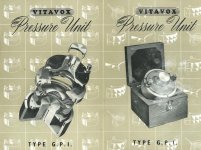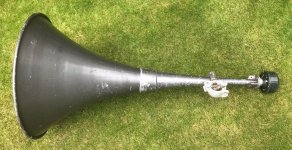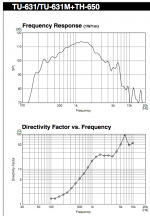Thoughts on Pressure Drivers for PA such as TOA TU-631 / TU-631M / TU-651 / TU-651M?
Hi Everyone,
I'm looking to buy some replacement pressure drivers (1 3/8" thread) to replace two damaged Vitavox GP1 pressure units and connect to the existing horn speakers that I have. This is for a temporary external public address set-up for a community fair.
I have heard that TOA is a very reputable company with decent products, and notice that they have several reasonably-priced drivers such as the TU-631, TU-651 and their corresponding constant-voltage equivalents, the TU-631M and TU-651M - see here:
TU-631 | TOA Corporation
Does anyone have any experience of these, or have any recommendations for alternatives (bearing in mind that I am looking for an inexpensive solution for temporary outdoor public address)? A lot of people seem to be very strong advocates of vintage Vitavox products, so will these be radically different (for better or worse) or perfectly adequate for my purposes of background fair music and occasional announcements?
Thanks in advance for any help - some of you might have seen another thread I created yesterday on speaker layout on a field, and as people were so helpful I though I would try my luck again!
Many thanks,
Andy.
Hi Everyone,
I'm looking to buy some replacement pressure drivers (1 3/8" thread) to replace two damaged Vitavox GP1 pressure units and connect to the existing horn speakers that I have. This is for a temporary external public address set-up for a community fair.
I have heard that TOA is a very reputable company with decent products, and notice that they have several reasonably-priced drivers such as the TU-631, TU-651 and their corresponding constant-voltage equivalents, the TU-631M and TU-651M - see here:
TU-631 | TOA Corporation
Does anyone have any experience of these, or have any recommendations for alternatives (bearing in mind that I am looking for an inexpensive solution for temporary outdoor public address)? A lot of people seem to be very strong advocates of vintage Vitavox products, so will these be radically different (for better or worse) or perfectly adequate for my purposes of background fair music and occasional announcements?
Thanks in advance for any help - some of you might have seen another thread I created yesterday on speaker layout on a field, and as people were so helpful I though I would try my luck again!
Many thanks,
Andy.
Last edited:
Andy,I'm looking to buy some replacement pressure drivers (1 3/8" thread) to replace two damaged Vitavox GP1 pressure units and connect to the existing horn speakers that I have. This is for a temporary external public address set-up for a community fair.
I have heard that TOA is a very reputable company with decent products, and notice that they have several reasonably-priced drivers such as the TU-631, TU-651 and their corresponding constant-voltage equivalents, the TU-631M and TU-651M - see here:
Does anyone have any experience of these, or have any recommendations for alternatives (bearing in mind that I am looking for an inexpensive solution for temporary outdoor public address)?
A lot of people seem to be very strong advocates of vintage Vitavox products, so will these be radically different (for better or worse) or perfectly adequate for my purposes of background fair music and occasional announcements?
The Vitavox G.P.I. use aluminum diaphragms, probably impossible to source replacements, though like vintage JBL and Altec, there are no doubt people that will pay dearly for them.
Most "P.A." compression drivers use phenolic diaphragms, which won't reproduce the very high frequencies as well as your Vitavox drivers.
Folded "re-entrant" horn response itself tends to obscure the difference between the high frequency drivers used.
Like most, older TOA drivers used phenolic diaphragms, while the newer TU-631/651 use Polyimide, improving both low and high frequency response compared to most competitors.
They will also handle more power than the Vitavox G.P.I., though you still should use a crossover to protect them at low frequencies.
No reason to waste power below the horn cut-off frequency, generally above 200 Hz even for fairly large re-entrant horns.
Also, as Conanski already mentioned in your other thread, at only 2.5 meter elevation, you are better to use the six PA horns 25 meters apart in your 200 meter long field, though the SPL (sound pressure level) variation at that little elevation still will be awful, dropping from 100 dB near the horn (car horn loud) to around 62 dB (lower than ambient noise levels at a fair) at 80 meters.
A 10 dB SPL variation sounds half as loud, doubling distance drops 6dB.
Find a way to get those horns safely high in the air , whether scaffold, crank lifts, a boom truck or whatever.
Cheers,
Art
Attachments
Hi Art, All,
Thanks so much for your detailed reply, which I read to be pretty supportive of this type of pressure driver from TOA.
There are a couple of things I thought it might be helpful to add in response to your helpful comments relating to this and my other related thread (Speaker Layout for Public Address at a Community Fair):
1) The speaker type that I am using is a large exponential horn - please see the attached image. Does that make any significant difference to whether or not to use these TOA drivers? My experience of these from the past with my father using them is that they give a clear, powerful, highly-directional sound, so six of these being well positioned in two groups of three as high as I can get them should, I hope, be sufficient to cover the c. 200m x 100m area I have.
2) I did a little 'site survey' yesterday and there is a pavilion there (that will not be used) and by using the balcony I can probably get to about 6-8m high, which should help a bit! Two groups of three speakers at each end, roughly in the middle of the long side of the 200m x 100m area being covered, is an option I am considering.
3) I'm going to go down the constant-voltage route (there is a 100V output on the amp) and probably get the TU-631M model (unless anyone has a better, reasonably-priced alternative) to give a bit more flexibility for this and future installs. That should enable me to tweak the volume in each direction and reduce cable loss.
Cheers,
Andy.
Thanks so much for your detailed reply, which I read to be pretty supportive of this type of pressure driver from TOA.
There are a couple of things I thought it might be helpful to add in response to your helpful comments relating to this and my other related thread (Speaker Layout for Public Address at a Community Fair):
1) The speaker type that I am using is a large exponential horn - please see the attached image. Does that make any significant difference to whether or not to use these TOA drivers? My experience of these from the past with my father using them is that they give a clear, powerful, highly-directional sound, so six of these being well positioned in two groups of three as high as I can get them should, I hope, be sufficient to cover the c. 200m x 100m area I have.
2) I did a little 'site survey' yesterday and there is a pavilion there (that will not be used) and by using the balcony I can probably get to about 6-8m high, which should help a bit! Two groups of three speakers at each end, roughly in the middle of the long side of the 200m x 100m area being covered, is an option I am considering.
3) I'm going to go down the constant-voltage route (there is a 100V output on the amp) and probably get the TU-631M model (unless anyone has a better, reasonably-priced alternative) to give a bit more flexibility for this and future installs. That should enable me to tweak the volume in each direction and reduce cable loss.
Cheers,
Andy.
Attachments
Last edited:
Andy,Hi Art, All,
Thanks so much for your detailed reply, which I read to be pretty supportive of this type of pressure driver from TOA.
1) The speaker type that I am using is a large exponential horn - please see the attached image. Does that make any significant difference to whether or not to use these TOA drivers?
2)..by using the balcony I can probably get to about 6-8m high, which should help a bit! Two groups of three speakers at each end, roughly in the middle of the long side of the 200m x 100m area being covered, is an option I am considering.
3) I'm going to go down the constant-voltage route (there is a 100V output on the amp) and probably get the TU-631M model (unless anyone has a better, reasonably-priced alternative) to give a bit more flexibility for this and future installs. That should enable me to tweak the volume in each direction and reduce cable loss.
Just for reference, these types of loudspeaker components are normally referred to as "compression drivers", as they use a compression chamber behind the diaphragm.
In over 40 years in the business had never seen the term "pressure driver" used before seeing your thread(s) and looking at the old Vitavox literature.
1) All compression drivers can be used on exponential horns.
"P.A." compression drivers like the TOA you are considering have a much lower resonant frequency than most current thread on drivers that are designed for use above 1000Hz. The TOA TH-650 or TH-660 are folded ("re-entrant"/"reflex") horns similar to your straight exponential horns.
The straight exponential horns have a bit smoother frequency response, but a lot more wind resistance, and the depth obviously is a disadvantage in many locations.
With a steep crossover filter at around 300 Hz and some equalization, your horn with those drivers should provide flat response from 300Hz to 6kHz.
2) "A bit" would be an understatement, that height difference will lessen the near to far SPL variation by around 20dB, and eliminate most overlap areas that would be perceived as echos.
3)Tapped transformers are a huge help for this type of work, each of the 5 taps on the TU-631M reducing level by 3dB, making it easy to reduce the level of a horn that covers a lesser distance, while still using single cable runs.
Art
Attachments
Last edited:
Thanks again, Art.
I think my 'jumbling' of terminology (I have used both 'compression driver' and 'pressure driver' at different times, in my own head at least!) comes as you have found from the old Vitavox unit - the vintage kit uses vintage terminology!
I think I'm good to go now... I have ordered the compression(!) drivers.
Cheers,
Andy.
I think my 'jumbling' of terminology (I have used both 'compression driver' and 'pressure driver' at different times, in my own head at least!) comes as you have found from the old Vitavox unit - the vintage kit uses vintage terminology!
I think I'm good to go now... I have ordered the compression(!) drivers.
Cheers,
Andy.


